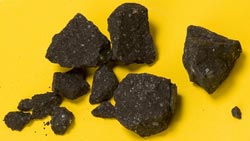ASU scientists strike scientific gold with meteorite

A portion of the asteroidal Sutter's Mill meteorite used in this study.<br>
Scientists led by Sandra Pizzarello, a research professor in ASU's Department of Chemistry and Biochemistry, found that the Sutter’s Mill meteorite, which exploded in a blazing fireball over California last year, contains organic molecules not previously found in any meteorites.
These findings suggest a far greater availability of extraterrestrial organic molecules than previously thought possible, an inventory that could indeed have been important in molecular evolution and life itself.
The work is being published in this week’s Proceedings of the National Academy of Sciences http://dx.doi.org/10.1073/pnas.1309113110; 2013. The paper is titled “Processing of meteoritic organic materials as a possible analog of early molecular evolution in planetary environments,” and is co-authored by Pizzarello, geologist Lynda Williams, NMR specialist Gregory Holland and graduate student Stephen Davidowski, all from ASU.
Coincidentally, Sutter’s Mill is also the gold discovery site that led to the 1849 California Gold Rush. Detection of the falling meteor by Doppler weather radar allowed for rapid recovery so that scientists could study for the first time a primitive meteorite with little exposure to the elements, providing the most pristine look yet at the surface of primitive asteroids.
“The analyses of meteorites never cease to surprise you … and make you wonder,” explains Pizzarello. “This is a meteorite whose organics had been found altered by heat and of little appeal for bio- or prebiotic chemistry, yet the very Solar System processes that lead to its alteration seem also to have brought about novel and complex molecules of definite prebiotic interest such as polyethers.”
Pizzarello and her team hydrothermally treated fragments of the meteorite and then detected the compounds released by gas chromatography-mass spectrometry. The hydrothermal conditions of the experiments, which also mimic early Earth settings (a proximity to volcanic activity and impact craters), released a complex mixture of oxygen-rich compounds, the probable result of oxidative processes that occurred in the parent body. They include a variety of long chain linear and branched polyethers, whose number is quite bewildering.
This addition to the inventory of organic compounds produced in extraterrestrial environments furthers the discourse of whether their delivery to the early Earth by comets and meteorites might have aided the molecular evolution that preceded the origins of life.
Jenny Green, jenny.green@asu.edu
480-965-1430
Department of Chemistry and Biochemistry
Media Contact
More Information:
http://www.asu.eduAll latest news from the category: Earth Sciences
Earth Sciences (also referred to as Geosciences), which deals with basic issues surrounding our planet, plays a vital role in the area of energy and raw materials supply.
Earth Sciences comprises subjects such as geology, geography, geological informatics, paleontology, mineralogy, petrography, crystallography, geophysics, geodesy, glaciology, cartography, photogrammetry, meteorology and seismology, early-warning systems, earthquake research and polar research.
Newest articles

Skyrmions move at record speeds
… a step towards the computing of the future. An international research team led by scientists from the CNRS1 has discovered that the magnetic nanobubbles2 known as skyrmions can be…

A flexible and efficient DC power converter for sustainable-energy microgrids
A new DC-DC power converter is superior to previous designs and paves the way for more efficient, reliable and sustainable energy storage and conversion solutions. The Kobe University development can…

Technical Trials for Easing the (Cosmological) Tension
A new study sorts through models attempting to solve one of the major challenges of contemporary cosmic science, the measurement of its expansion. Thanks to the dizzying growth of cosmic…




















